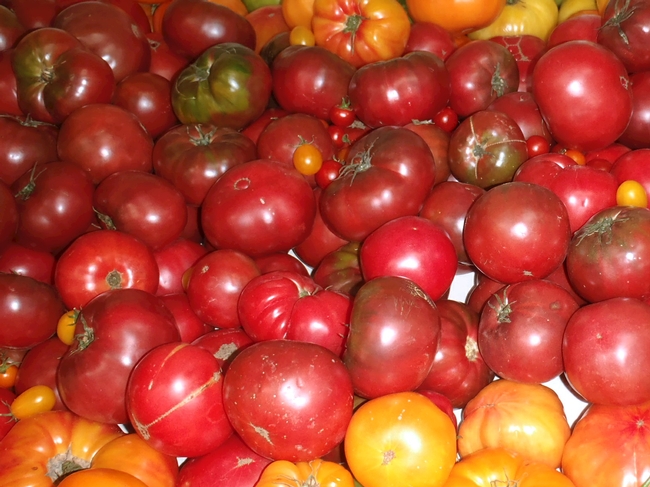Tomato Trivia or It Is Just Too Hot to Be Very Serious
If you were to poll the Master Gardeners who sit at information booths and answer questions from the public regarding problems they might be having in their gardens, my bet would be that the majority of those questions deal with tomatoes. And understandably so, as 93 percent of home gardeners in the U.S. grow tomatoes. I thought, just for fun, I'd look at some other interesting facts regarding this fruit, er, I mean vegetable, I mean, er well, whatever.
The Department of Agriculture states that Americans eat between 22-24 pounds of tomatoes per year, but most of that is in the form of either ketchup or tomato sauce. In recent years, salsa has passed up ketchup. (Ketchup always has run slow.--sorry, couldn't resist) At the grocery market, the tomato is the 4th most popular vegetable, running behind potatoes, lettuce, and onions.
Americans have increased their consumption of the tomato over the past 20 years by 30 percent, mostly in the processed forms of sauces, paste, and salsa. I realize that I have no memory as a kid of eating salsa. When did that get invented? And even more important, what did we put on those chips?
Fresh market tomatoes are raised in all 50 states, the majority grown in Florida. However, California grows 96 percent of the tomatoes that are processed. Worldwide, China grows the most, the U.S. second.
The tomato is believed to have originally come from Peru, its Aztec name being "xitomati", which means "plump thing with a navel". The scientific name is Lycopersicon lycopersicum which means "wolf peach".
No one can agree on how many variety of tomatoes there are. The estimates run between 10,000 and 25,000. My guess as to why there is this discrepancy is because new varieties are constantly popping up. Isn't 25,000 enough? I already have such a hard time every spring deciding what variety to plant.
The heaviest tomato recorded weighed in at 7 lbs. 12 oz., grown by Gordon Graham of Oklahoma in 1986. After weighing, Mr. Graham sliced the tomato and made sandwiches for 21 people.
The largest known tomato plant was a 'Sungold' variety, whose height was recorded in the year 2000 as 65 feet tall. It was grown by a company in the U.K. (I have a 'Sungold', and up to this very minute, thought it was doing very well at 6 feet.)
The tomato is the official fruit and vegetable of Arkansas while the official drink of Ohio is tomato juice.
The largest tomato festival in the U.S. appears to be the one held in Arkansas which continues for a whole week and has over 30,000 visitors and tasters. However, if you really want to have fun, you may want to go to Spain on the last Wednesday in August for La Tomatina where 30,000 participants throw 150,000 tons (not pounds, but tons) of over ripe tomatoes at each other. Guess that is better than throwing over ripe watermelons.
Now to answer that age old question, is the tomato a fruit or a vegetable? Botanically, a tomato is the ovary, together with its seeds, of a flowering plant. Therefore it is a fruit or, more precisely, a berry. But by US tariff laws, a tomato is consider a vegetable. The applicable law define produce by its use and not its scientific classification. From a culinary point of view, a tomato is a vegetable.
So, Farmers Market Master Gardeners, this article may not be helpful to you in solving that one difficult tomato question, but you will have a lot to chat about while your partner at the table looks up the answer.

Tomatoes. (photo by Betty Homer)


Posted by bil on August 3, 2013 at 2:38 PM